and some of the largest casinos in the world, the city rivals Hong Kong as a tourist destination
I am sitting on a distressed couch dressed in a terry cloth bathrobe with my feet in a clay basin of warm water on a wood and undressed-stone floor. The lights are dim. Music plays gently in the background. The air is rich with the scent of blended herbs. I can't help but relax, though it's hard to believe I'm doing so in Macau, once the poor relation of its richer, more sophisticated neighbor, Hong Kong.
This spa experience took place at the Crown Macau, one of the new, super-luxury hotels that have put Macau on a par with Hong Kong and Singapore for those who want to be pampered.
The growth in Macau's hospitality industry has been meteoric and a tourist boom has kept pace with it. In 2000, there were just under 10 million tourists to the area, last year there were 27 million, according to Macau Government Tourism Office (MGTO) figures.
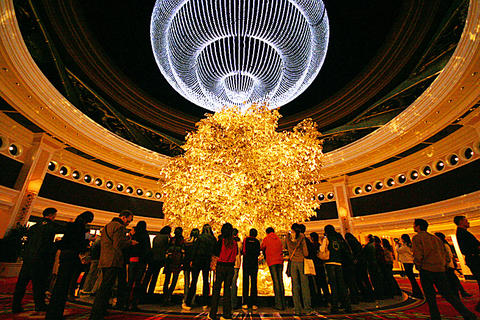
IAN BARTHOLOMEW. TAIPEI TIMES AND COURTESY OF CROWN. LISBOA. MGM
While the luxury at the Crown, designed by Peter Remedios (the man behind the look of the Four Seasons New York and Hong Kong's Landmark Oriental) is accessible to tourists with a healthy bank account, it's high-rolling gamblers who keep the business going. For example, playing in the super VIP gambling area at the Crown requires access to NT$1 million.
Naturally, some amenities cater to big spenders. Other services, like an NT$7,000 spa treatment, are treats accessible to more mainstream visitors.
All of the Crown's rooms look across the water from Taipa Island to the peninsula of Macau proper. "We don't want anyone to have anything less than the best view," said Crown Macau PR manager Charles Ngai. When he talks of six-star service, it's not just sales hype.
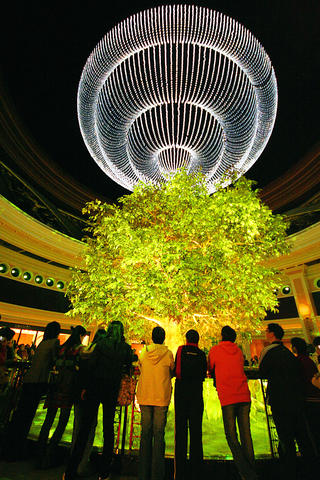
IAN BARTHOLOMEW. TAIPEI TIMES AND COURTESY OF CROWN. LISBOA. MGM
The Crown is not alone in offering high-end vacation spots. The MGM Grand Macau opened last month, Wynn Macau opened two years ago and has just finished its second-phase extension. Grand Lisboa's casino is up and running, and the hotel is scheduled to open later this year. On the Cotai Strip, a piece of reclaimed land that links Coloane and Taipa islands, Four Seasons is building a luxury hotel, and Crown has already started work on another, to be called City of Dreams. The list goes on: Sheraton, the Hilton, Fairmont, Raffles and Shangri-La hotels are all in development. According to the MGTO, 26 major hotel developments are currently underway.
Getting into these rooms, though, isn't always easy, especially around holidays. At the 216-room Crown Towers, rooms are often pre-booked by big-time out-of-town gamblers.
Though people from all over the world visit Macau, the bulk of business comes from China. Business is seldom slow and nowhere can this be seen more clearly than at The Venetian, owned by the Las Vegas Sands Corp. Blue hotel buses bring in a continuous stream of visitors. The check-in area resembles an airport after all flights have been canceled. With 3,000 rooms and a gambling hall larger than five football fields, 800 tables and 6,000 slot machines, there is plenty for everyone.
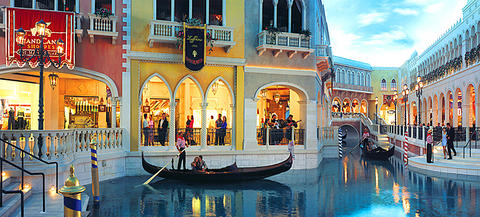
IAN BARTHOLOMEW. TAIPEI TIMES AND COURTESY OF CROWN. LISBOA. MGM
The Venetian, with its theme-park design, might be sneered at by sophisticates, but is a thrill for families. You can take a gondola ride in a canal, with a real Italian gondolier (who can sing), in an ersatz gondola (they're motorized).
Although the hotel, casino and convention center opened last year and is new enough that you can still smell the glue used to hold the paneling in place, it has already played host to Manchester United players, who played in Macau in July, and Pete Sampras and Roger Federer when they played an exhibition tennis match in November. This is besides, of course, regular business conferences.
Wynn Macau is slightly smaller than its Las Vegas brother, even after its recent expansion. It does, however offer luxury label outlets such as Chanel, Van Cleef & Arpels, Vertu, Bulgari and Ermenelildo Zegna, as well as Wynn's own designer label. But while the shopping malls, no matter how exclusive and expensive, are far from unique, other aspects of the hotel have made it a destination even for people not staying there.
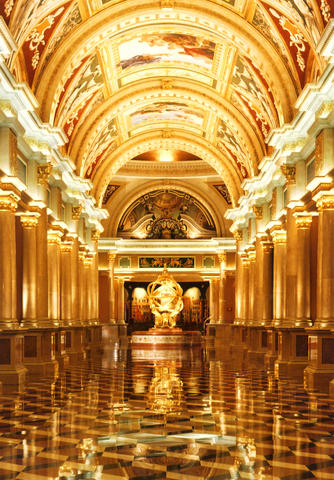
IAN BARTHOLOMEW. TAIPEI TIMES AND COURTESY OF CROWN. LISBOA. MGM
The Tree of Prosperity is one such draw. A kinetic sculpture featuring Western and Chinese zodiac signs and other cosmological imagery, it was put together by British designer Mark Fisher. The 11m tree has 98,000 24-karat-gold leaves and rises from the floor of the hotel's atrium on a fixed daily schedule. The chandelier is made of 13,000 crystals. There is also the Performance Lake, which combines a 200-spout fountain, lighting, fire jets and music, which can be watched from the hotel's front court, or from a window seat at the hotel's Restorante Il Teatro. "It's about creating an inclusive experience," said Reddy Leong, Wynn's PR manager. "Just focusing on the casino is not enough."
Other hotels also offer similar sights. At the Grand Lisboa, a Tang Dynasty bronze horse head (donated to the Chinese government by Stanley Ho, 何鴻燊) stands at the casino's main entrance. Other bronzes by Taiwanese artist Ju Ming (朱銘) stand beneath crystal chandeliers in the lobby of the soon-to-open hotel.
If you don't want to blow your pension in the hope that 28 will turn up on the roulette wheel, dining is a good diversion. With big money and six-star hotels come top chefs from around the world. While many of the territory's restaurants can offer opportunities to spend indecent amounts of money on exotic food and wine, they generally also have affordable set-lunch menus.
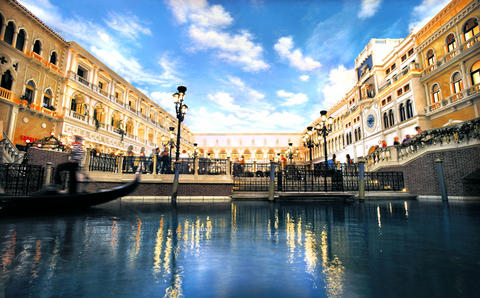
IAN BARTHOLOMEW. TAIPEI TIMES AND COURTESY OF CROWN. LISBOA. MGM
Western culinary highlights include The Lisboa's Robuchon a Galera, which is owned by three-star Michelin chef Joel Robuchon. The hotel's The Kitchen offers ambiance, innovative menus and good service, though without the celebrity cachet. Don Alfonso 1890 is a Mediterranean restaurant with its own line of products, all imported from its own farm in southern Italy.
Upscale contemporary Cantonese cuisine is available at establishments such as Chef Leo at MGM Grand. That said, there's also a wide range of typical Macanese food as well. Lokkei Congee and Noodles (六記粥麵), located by the Macau docks since 1945, is one of the best, and if lady luck hasn't been kind, affordable at NT$200. Be prepared to queue with the hoi polloi.
Macau's version of Portuguese food is another unique culinary experience, including African chicken, pasties of salted fish, suckling pig and grilled sardines washed down with some chilled Vinho Verde. Check out Escada, located in a refurbished historic building in downtown Macau, or take a bus to the ramshackle Fernando's, located on the beachside of Coloane. You don't get the fancy presentation or the skyline, but the food and homey atmosphere provide a nice contrast to the swank and glitter of the hotels.
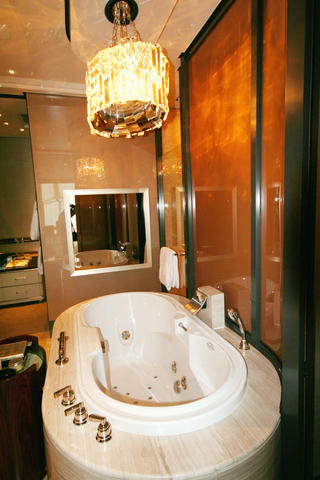
IAN BARTHOLOMEW. TAIPEI TIMES AND COURTESY OF CROWN. LISBOA. MGM
Macau, fast growing up and out, is a place for those who know how to treat themselves well.
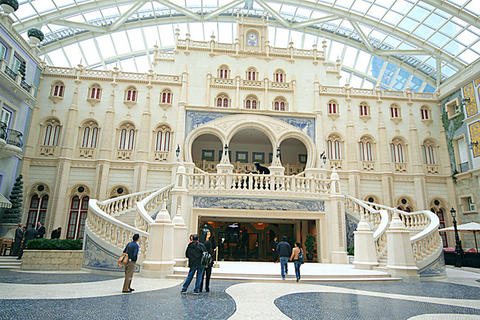
IAN BARTHOLOMEW. TAIPEI TIMES AND COURTESY OF CROWN. LISBOA. MGM
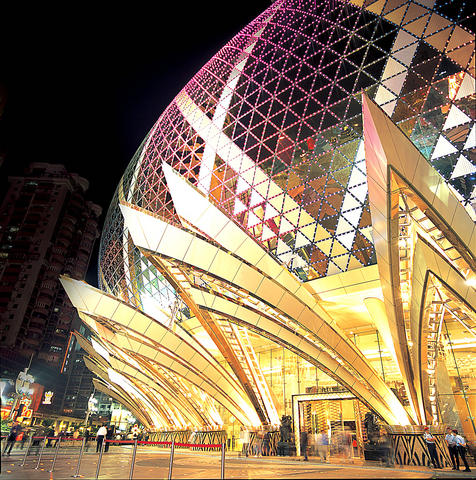
IAN BARTHOLOMEW. TAIPEI TIMES AND COURTESY OF CROWN. LISBOA. MGM
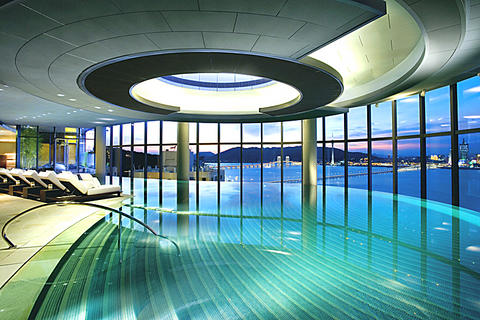
IAN BARTHOLOMEW. TAIPEI TIMES AND COURTESY OF CROWN. LISBOA. MGM
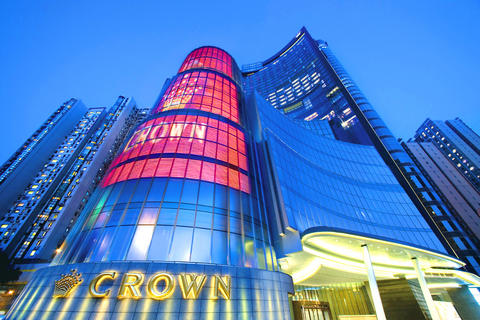
IAN BARTHOLOMEW. TAIPEI TIMES AND COURTESY OF CROWN. LISBOA. MGM
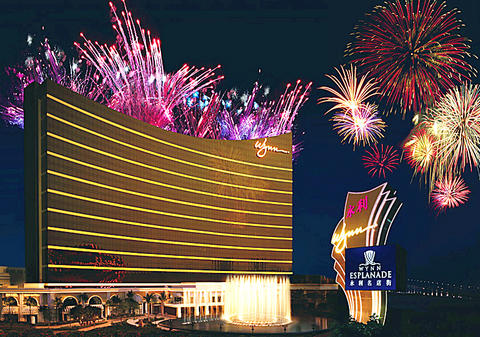
IAN BARTHOLOMEW. TAIPEI TIMES AND COURTESY OF CROWN. LISBOA. MGM

May 11 to May 18 The original Taichung Railway Station was long thought to have been completely razed. Opening on May 15, 1905, the one-story wooden structure soon outgrew its purpose and was replaced in 1917 by a grandiose, Western-style station. During construction on the third-generation station in 2017, workers discovered the service pit for the original station’s locomotive depot. A year later, a small wooden building on site was determined by historians to be the first stationmaster’s office, built around 1908. With these findings, the Taichung Railway Station Cultural Park now boasts that it has

The latest Formosa poll released at the end of last month shows confidence in President William Lai (賴清德) plunged 8.1 percent, while satisfaction with the Lai administration fared worse with a drop of 8.5 percent. Those lacking confidence in Lai jumped by 6 percent and dissatisfaction in his administration spiked up 6.7 percent. Confidence in Lai is still strong at 48.6 percent, compared to 43 percent lacking confidence — but this is his worst result overall since he took office. For the first time, dissatisfaction with his administration surpassed satisfaction, 47.3 to 47.1 percent. Though statistically a tie, for most

Wooden houses wedged between concrete, crumbling brick facades with roofs gaping to the sky, and tiled art deco buildings down narrow alleyways: Taichung Central District’s (中區) aging architecture reveals both the allure and reality of the old downtown. From Indigenous settlement to capital under Qing Dynasty rule through to Japanese colonization, Taichung’s Central District holds a long and layered history. The bygone beauty of its streets once earned it the nickname “Little Kyoto.” Since the late eighties, however, the shifting of economic and government centers westward signaled a gradual decline in the area’s evolving fortunes. With the regeneration of the once

In February of this year the Taipei Times reported on the visit of Lienchiang County Commissioner Wang Chung-ming (王忠銘) of the Chinese Nationalist Party (KMT) and a delegation to a lantern festival in Fuzhou’s Mawei District in Fujian Province. “Today, Mawei and Matsu jointly marked the lantern festival,” Wang was quoted as saying, adding that both sides “being of one people,” is a cause for joy. Wang was passing around a common claim of officials of the People’s Republic of China (PRC) and the PRC’s allies and supporters in Taiwan — KMT and the Taiwan People’s Party — and elsewhere: Taiwan and